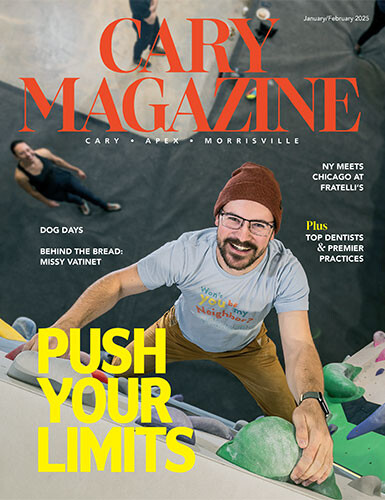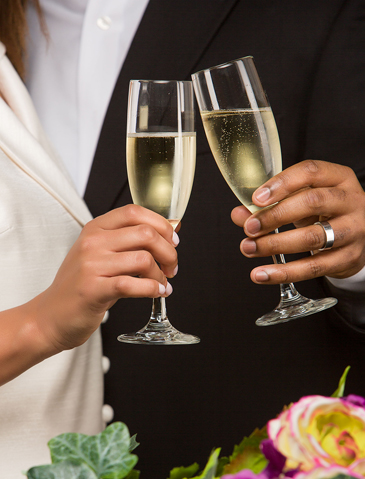AH, THE POP OF A CORK, the rise of the bubbles. Toasting the new bride and groom is a longheld and sentimental wedding tradition.
But which champagne or sparkling wine is your best choice for this magic moment, and how
much of it will you need?
To find out, we sought the advice of Kurt Saylor, senior manager at The Wine Merchant in Cary.
The shop is winner of the 2014 Maggy Award, voted by Cary Magazine readers as best local shop for wine and beer.
“The wedding toast is very ceremonial,” Saylor said, “and the champagne toast for couples is a must. “When we see couples and their parents come in frazzled with wedding planning, we tell them ‘This is the fun thing on your to-do list!’”
The first step in choosing wedding champagne is to determine the bridal couple’s experience with the beverage; true champagne, Saylor notes, is made only from grapes grown in the Champagne region of France.
All other options are considered sparkling wines.
From here choices are narrowed from tete de Cuvée, meaning top of the line, to the more typical Brut. Chances are, most people aren’t able to tell the difference between a $100 bottle of champagne and a $30 bottle, Saylor says.
But communication is key, from the couple’s personal preferences to discussion of their per-bottle budget.
To calculate quantity, Saylor uses a formula factoring the number of guests with the time and length of the reception, other alcohol offered, and the serving style of the meal.
For wedding venues that charge corkage fees to bring in wines, he suggests consulting with a wine shop on the venue’s wine menu, regarding pricing and additional options.
Couples are also encouraged to taste a selection of wines to compare taste and cost. Oftentimes they find it a better value to buy from a wine shop and pay the venue’s corkage fee, Saylor says.
 Most wedding wines purchased at his shop cost under $10. However, if true French champagne is your heart’s desire, expect to pay $30 per bottle and up. Some choose to serve a less expensive champagne or wine to guests, reserving a high-end vintage for just the bride and groom.
Most wedding wines purchased at his shop cost under $10. However, if true French champagne is your heart’s desire, expect to pay $30 per bottle and up. Some choose to serve a less expensive champagne or wine to guests, reserving a high-end vintage for just the bride and groom.
Saylor also recommends ensuring the venue is prepared for the wedding toast, with champagne-specific flutes and proper staffing for that special moment.
There’s a correct way to serve champagne, to avoid flying corks and messy spews.
“Always put your thumb on top of the cork as you untwist the (wire) cage,” Saylor said. After removing the cage, hold the cork, tilt the bottle at a 45-degree angle and twist its bottom for control, while pulling out the cork slowly. A towel can help catch any spillage.
Then again … the champagne toast is a celebration. Let that cork pop, newlyweds, and enjoy the bubbles’ rise.
The Wine Merchant, Cary
(919) 469-1330
winemerchantraleigh.com





